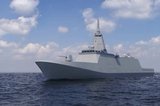Autonomous capabilities open doors for expeditionary fast transport to undertake new missions
The future USNS Apalachicola (EPF 13), pictured in 2021. (Photo: Austal)
On 29 July, the USN announced the thirteenth Spearhead-class Expeditionary Fast Transportvessel (EPF 13) was performing a series of planned test events to assess autonomous capabilities integrated into the ship to demonstrate a large ship can become a 'self-driving platform'.
Dubbed the 'Unmanned Logistics Prototype trials', the USN said each test event would increase 'the perception capabilities and complexity of behaviours demonstrated by the autonomous systems.'
As of 29 July, test evolutions included point-to-point autonomous navigation, vessel handling and transfer of control of the vessel between crewed and uncrewed modes.
Shipbuilder Austal USA told Shephard that integrating autonomous capabilities
Already have an account? Log in
Want to keep reading this article?
More from Naval Warfare
-
![Future of the Canadian Patrol Submarine Project is still unclear]()
Future of the Canadian Patrol Submarine Project is still unclear
The Canadian government remains tight-lipped on the timeline and funding required for the next steps of its Canadian Submarine Patrol Project, which should offer improved capabilities for the country’s navy.
-
![Thales’ new Sonar 76Nano could equip UK Royal Navy on anti-submarine warfare missions]()
Thales’ new Sonar 76Nano could equip UK Royal Navy on anti-submarine warfare missions
The new sonar is designed to equip uncrewed underwater vessels, with the potential to be used by the Royal Navy for its Atlantic Bastion and Atlantic Net missions.
-
![Hanwha wins Australian government approval to increase its stake in Austal]()
Hanwha wins Australian government approval to increase its stake in Austal
The contract would mean the two shipbuilders can collaborate strategically and enhance shipbuilding capabilities in Western Australia.






















